Why Del Frisco's Double Eagle Steakhouse Is So Expensive
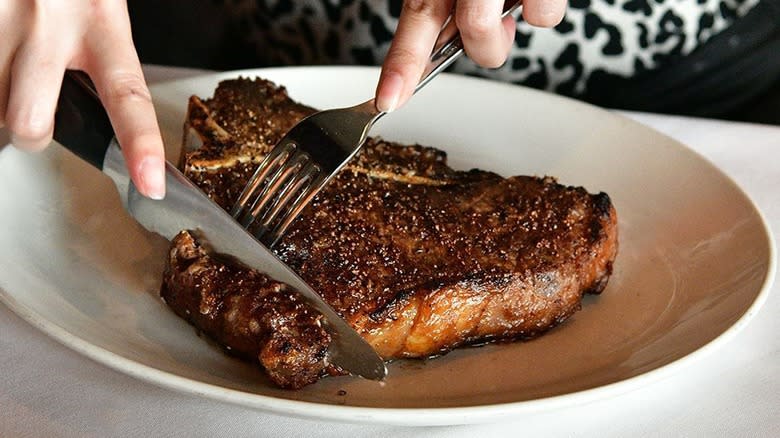
If an individual is in the market for an exceptionally lavish and unabashedly decadent dining experience, a visit to Del Frisco's Double Eagle Steakhouse makes for an excellent choice. The chain of 17 massive and expressly elegant no-expense-sparing steakhouses, located in some of the most well-appointed neighborhoods in major American cities, is in the business of providing a classic, old-fashioned steakhouse experience.
It's made all the more impressive and indulgent through modern and sophisticated touches, and most importantly, by the food. At the forefront of Del Frisco's Double Eagle Steakhouse operation is a menu that features some of the most exclusive cuts available to American diners, dry-aged and prepared by chefs in state-of-the-art kitchens. And that's to say nothing of the other quintessential steakhouse fare, like fresh fish, classic sides, and desserts.
Understandably, that all suggests that a trip to Del Frisco's Double Eagle Steakhouse will be as expensive as it is satisfying. The average ticket price per diner can run into the hundreds, given that the entrees alone fall into the $100 range. (And that's not even including the sides, appetizers, and wine.) But the steakhouse chain's operators can justify the big numbers staring back at customers from the menu — or at least, there's logic to be found behind them. Here are the many factors that make Del Frisco's Double Eagle Steakhouse so very expensive.
Read more: The Best Steakhouse In Every State
The Company Spends A Lot On Real Estate
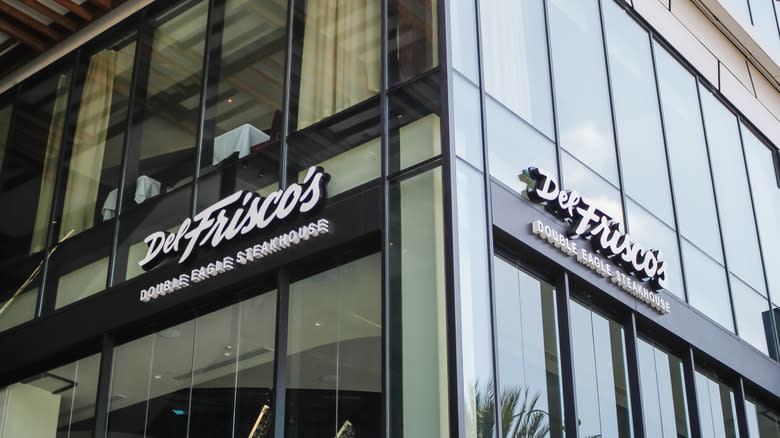
The sunken costs of a luxurious steakhouse are great and varied. If a restaurant company wants to attract the kind of clientele that's wealthy enough to readily spend a small fortune for a single dining experience, then they have to go to where those big spenders might be — financial districts, exclusive neighborhoods, and other areas of populous and economically robust cities. Setting up shop in these areas involves hefty real estate costs. Whether buying the buildings outright or leasing the land underneath their restaurants, Del Frisco's Double Eagle Steakhouse's parent company, Landry's, must regularly fork over exorbitant figures on real estate.
As of 2024, 17 Del Frisco's Double Eagle Steakhouses operate in the United States, all in areas where the money flows. For example, the outlet in Dallas sits in the tony Uptown neighborhood, the one in Houston sits adjacent to the city's business district, and the Las Vegas location is right off the expensive Vegas Strip. And while just getting into those areas is costly, the average Del Frisco's Double Eagle requires a lot of high price-tag space. The Manhattan and Houston outlets, for example, both occupy 17,000-square-foot areas, and the Chicago restaurant is a 24,000-square-foot establishment.
Good Beef And Seafood Don't Come Cheap
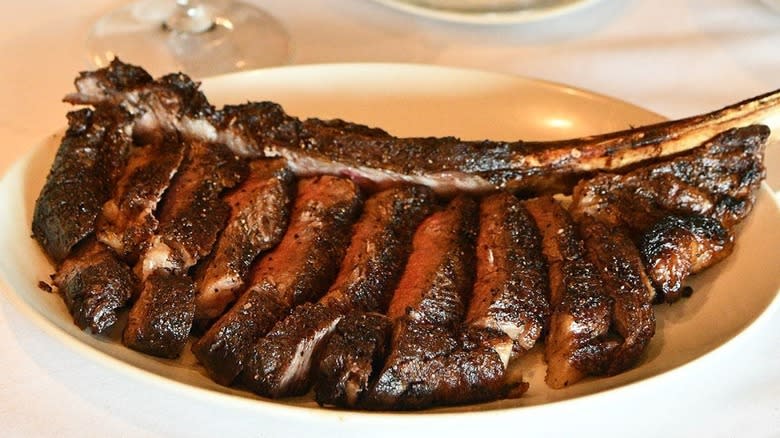
Steaks are generally among the more expensive items on a restaurant's menu, so a steak-centric establishment understandably boasts high prices across the board. Del Frisco's Double Eagle serves many different steaks, none of which could be considered bargain cuts. The restaurant uses top-rated USDA Prime grade beef, which, according to the USDA, offers "slightly abundant to abundant marbling," which offers a pleasant balance of meat and fat. It is also the typical grade used in restaurants and hotels. Only around 2% of American beef is deemed good enough to earn that Prime distinction; the rest of what is distributed is mostly lower-tier, less well-marbled Choice and Select grades.
Besides exquisite beef, Del Frisco's Double Eagle menu leans heavily on fish. A variety of appetizers, sides, and main courses feature several different seafood options, including salmon, shrimp, lobster, crab, calamari, oysters, and tuna. Seafood is so prevalent at Del Frisco's Double Eagle that salmon, shrimp, and lobster can be ordered as an add-on to a salad. An assortment of this variety can be found in the chilled shellfish tower, which is listed on the menu at "market price," owing to the constant fluctuations of the seafood marketplace. Rising labor costs, trade issues with wartime Russia, and other 2020s global issues have made the cost of seafood even greater. And that's considering the price is already high due to the process of catching, storing, and distributing it to the restaurant chain's various establishments.
Rare And Large Cuts Are Expensive
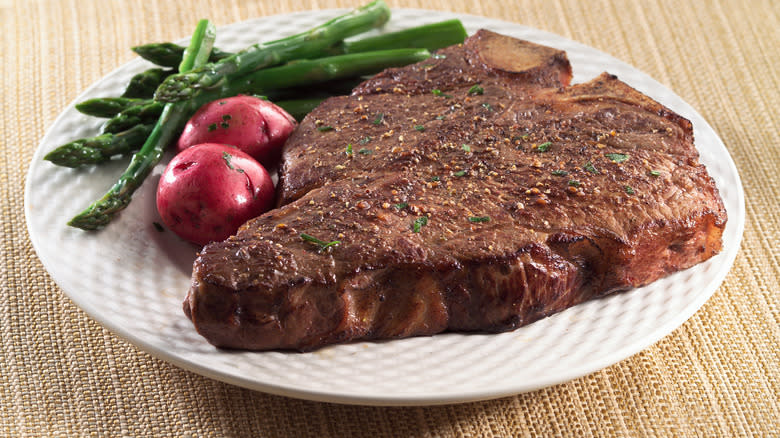
Because of the relative rarity of Prime beef, it's going to cost a lot more than a lower-quality steak. But at least the high-priced, high-quality steaks at Del Frisco's Double Eagle Steakhouse are show-stoppers. You simply won't find the kind of steaks that are commonplace at big-box grocery stores and mega-chains — skirt steak, medallions, generically-named sirloin — at Del Frisco's Double Eagle.
The elite chain's offerings come from the rarified parts of a cow, and they include classically fancy cuts like the filet mignon (in a moderate 8-ounce and a larger 12-ounce format), bone-in ribeye, and filet, as well as truly indulgent and massively portioned steaks, including a 24-ounce porterhouse and a 32-ounce tomahawk. The latter is essentially a personal, 2-pound rib roast, consisting of a ribeye steak with part of the meaty rib bone left intact. Due to size and scarcity, such steaks are costly and priced in the $100 range.
Patrons may also find specially produced cuts on Del Frisco's Double Eagle Steakhouse menu, either permanently or from time to time as limited specials. Notably, the chain enjoys access to both Wagyu and Kobe beef. Produced in small quantities primarily in Japan, it's some of the most prized and hard-to-find beef on the planet. But Del Frisco's uses Wagyu to make meatballs, and Kobe steaks are sometimes on offer as a special, exorbitantly priced treat.
Del Frisco's Double Eagle Is A Wine-Forward Establishment

Wine is an integral part of the fine dining experience for many patrons of top-tier restaurants. Del Frisco's Double Eagle Steakhouse positions itself as an eatery that's elaborately focused on wine. The average location boasts an extensive wine list with dozens of readily available whites, reds, sparkling, and dessert wines by the bottle, glass, or as part of a flight. Some outlets may have more than 1,000 options on hand, while the one in Chicago has been known to stock around 11,000 bottles at a time.
That makes Del Frisco's Double Eagle an attractive option for the widest audience possible, from wine neophytes to the most discerning connoisseurs. To fortify its wine collection — the winner of multiple coveted awards — with selections of various styles from around the world isn't a cheap proposition, as quality wine can be very expensive. Looked after by a staff sommelier, those wines are subject to a markup from the restaurant, giving the already costly wines at Del Frisco's an even heftier price tag.
The Interiors Cost A Lot
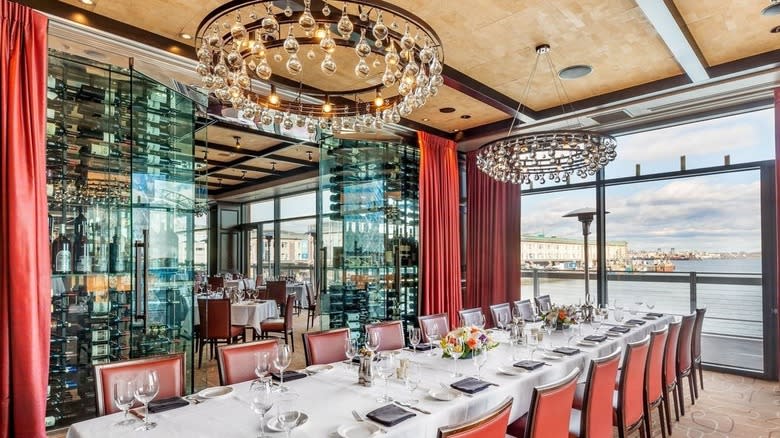
Del Frisco's Double Eagle Steakhouse markets and presents itself as a very classy destination restaurant, and thus a very expensive one, too. As if to prove and justify its self-created reputation, the chain welcomes and envelops its diners in an environment of luxury and opulence. The steakhouse chain's owners have dropped a lot of money to craft immersive restaurant spaces that fit with the expensive menu items sold therein.
The Houston branch of Del Frisco's Double Eagle Steakhouse opened in 2008, built as a re-creation of the chain's flagship location in Manhattan. Such an endeavor required massive (and massively expensive) windows, walls made from special mahogany wood, floors built from slate imported from Brazil, and a dining room lined with light fixtures constructed out of alabaster from Spain, which ran $75,000 each. Construction on the Houston location alone cost upwards of $11 million and that was in 2008, meaning it's going to cost parent company Landry's even more the next time it opens a new restaurant.
Dry-Aging Beef Is Costly And Time-Consuming
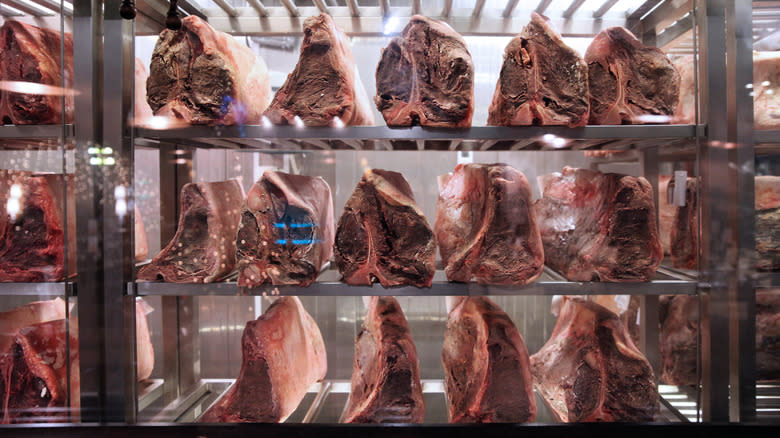
With some restaurant fare, the fresher it is, the better it tastes. That's true for seafood and vegetables, but not so much for steaks. For premium cuts of beef, producers employ aging techniques to improve the flavor and texture of the meat. High-end chains like Del Frisco's Double Eagle utilize a technique called dry-aging, a lengthy and involved process. It requires hanging large amounts of meat on racks for a period ranging from a few days to multiple weeks. As the beef sits and rests, the natural liquids inside the muscle tissue gradually dissipate, leaving behind a steak that's packed full of rich, undiluted, and complex flavor.
Dry-aging is conducted with only the best cuts of meat in special facilities where the flow of air and the temperature can be controlled at all times. The extra steps and equipment add to the cost of the already highly priced wholesale, premium cuts. That cost is ultimately reflected in high steak prices on Del Frisco's Double Eagle menu.
It Pays Its Employees Very Well

Del Frisco's Double Eagle Steakhouses are gilded temples of fine dining that serve high-end cuisine at non-bargain prices. Part of the high ticket price can be attributed to labor costs, to which the company devotes a lot of its funds. By offering a generous wage to employees, Del Frisco's Double Eagle can attract a higher caliber of talent, well worth the expense. The average location houses an extensive collection of wine, and a sommelier is necessary to keep track of it all and make recommendations. Such expertise is a valuable and marketable skill and a sommelier at Del Frisco's Double Eagle might earn as much as around $69,000 annually.
Similarly, Del Frisco's Double Eagle needs to employ servers who can contend with the sophisticated atmosphere and who are devoted to the top-notch service expected at a pricey restaurant. These servers must be appropriately and handsomely compensated for their work, and Del Frisco's Double Eagle obliges. A server at one of the company's restaurants earns an average of $536 in a daily shift. That's well over double what they'd earn at a competing classy steakhouse in the United States. Among the other restaurant employees, a general manager could be pulling in $122,000 annually while the bartender brings home $80,000.
Fancy And Trendy Ingredients Drive Up The Price
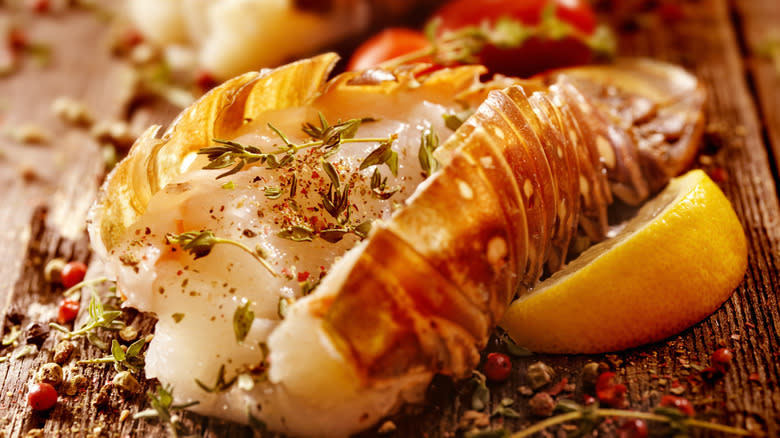
Relatively scarce and in-demand cuts of highly-graded beef from specially raised cattle are expensive at the wholesale and consumer levels, but the menu prices at Del Frisco's Double Eagle are also as elevated as they are because of the exclusivity of the selection. What could stand alone as appetizers, side dishes, or entrees at other establishments are often just ingredients in offerings at Del Frisco's Double Eagle Steakhouse. Imported, authentic Japan-raised wagyu steak is on the menu (a 6-ounce portion, a la carte, runs $160 in Las Vegas, as of early 2024), and the beef delicacy is also used as one of multiple ingredients in a hot appetizer meatball dish, combined with Spanish Manchego cheese and vegetables.
Similarly, caviar and smoked salmon, both high-end delicacies, are just two elements in the constructed Smoked Salmon French Toast. Additionally, the former is available on its own as a platter, with a price that changes daily according to the seafood market fluctuations. Lobster comes easy but not free at Del Frisco's Double Eagle, appearing in a sauce on the crab cakes, made into a bisque, or among the appetizers featuring just the tail.
The Kitchens Are Sophisticated
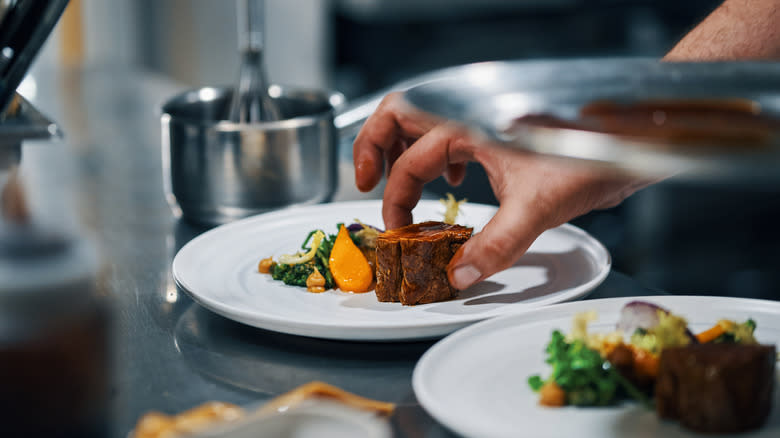
To ensure that its very expensive food is presented to customers exactly as it has been ordered and promised, Del Frisco's Double Eagle employs a complicated, semi-automated, and costly system. Once a server takes a table's order, they enter it into a handheld computer, which transmits the information to one of the kitchen's independently operating cooking quadrants, each presided over by a chef.
There's an appetizer station with fryers and multiple range-tops, and a refrigerated station to keep all the salad ingredients chilled during preparation. A third station is devoted entirely to fish, and a fourth is just for preparing desserts. An array of compact but industrial-strength broilers cook the hundreds of steaks that a Del Frisco's Double Eagle may prepare on demand on any given night. All of that extra space, technology, gear, and labor elevates the cost of running a restaurant, ultimately resulting in higher menu prices at this high-end steakhouse.
The Owners Spent A Lot On It
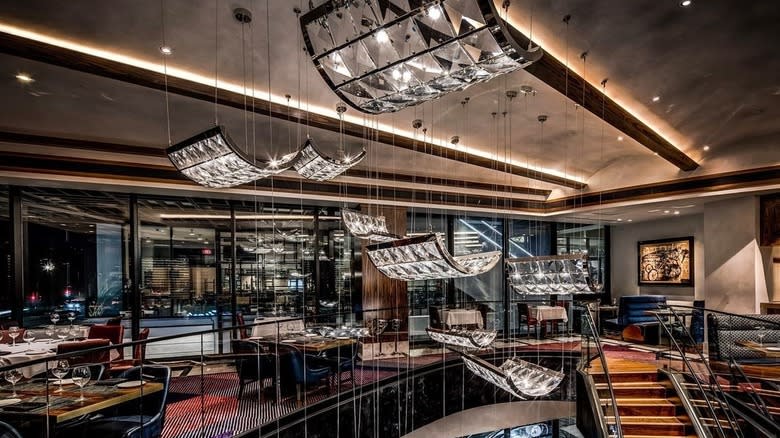
A night out at Del Frisco's Double Eagle Steakhouse can run on the expensive side, in part because it was so expensive to the parties that bought and now operate every store in the restaurant chain. In June 2019, the private equity group L Catterton purchased Del Frisco's Restaurant Group, Inc. The firm then immediately flipped its $650 million investment in Del Frisco's Double Eagle Steakhouse (and its less formal sibling chain, Del Frisco's Grille), yielding the whole business to Landry's, Inc., an umbrella company that runs a variety of other restaurants, including Morton's The Steakhouse, Bubba Gump Shrimp Company, and Joe's Crab Shack.
It's natural for Landry's to want to recoup its massive investment in the years after purchasing Del Frisco's Double Eagle. It's trying to make the most money possible for its shareholders, a tough task during a post-pandemic economic downturn, while also spending a lot of cash on the restaurant chain's food, labor, interior, and real estate. Big dollar amounts on the menu help Landry's break even or turn a profit.
Laundering Linens Costs A Lot Of Money
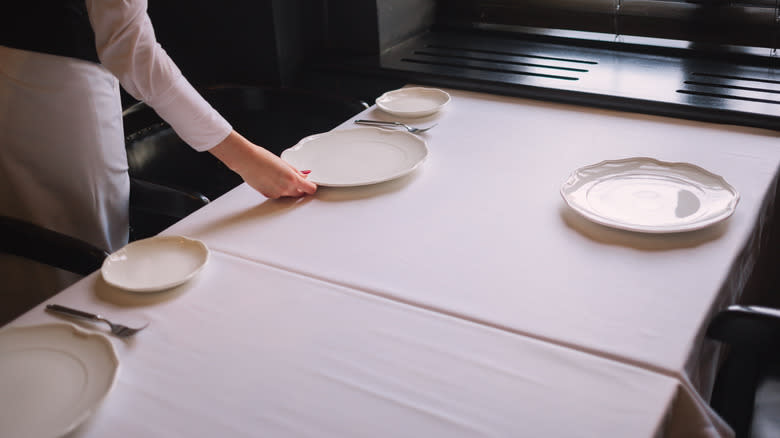
The average Del Frisco's Double Eagle Steakhouse is objectively large, sized anywhere between 12,500 and 24,000 square feet. This puts the seating capacity for each restaurant into the hundreds at any given time. As those tables may be turned over several times a day across lunch and dinner services, it's possible that a single Del Frisco's Double Eagle Steakhouse can feed around 1,000 people a day. That generates a lot of laundry, because every time a new party comes in, they need a fresh white tablecloth and matching napkins.
Those items are all made of cloth that needs to be laundered, as do all of the towels, uniforms, aprons, and chefs' whites used by the steakhouse's staff. Scores of items are regularly in need of washing, drying, folding, and stocking, and restaurants like Del Frisco's Double Eagle Steakhouse rely on an outside service to fulfill their substantial and never-ending laundry needs. Such linen-laundering firms may charge 25 cents per piece or more, generating a huge daily bill for the restaurant. That's one of the many costs of doing business, and it's certainly factored into the bill when calculating the price of menu items.
It's Expensive Because It's Expensive
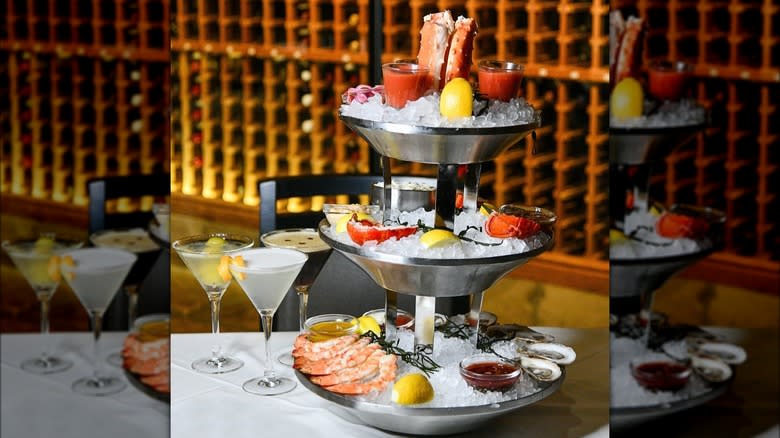
Del Frisco's Double Eagle Steakhouse opened for business in 1981 with a stated goal: to re-create the bold, decadent, and luxurious steakhouses that defined American fine dining a century prior for contemporary diners. In the four decades since, and through different owners and an expanding presence on an increasingly crowded steakhouse scene, the establishment has remained committed to its original vision. A meal at one of the company's steakhouses is about more than food; it's a spectacle. From the leather chairs and rich mahogany interiors to the well-compensated servers and sommeliers with hundreds of carefully selected wines at their disposal, excess and opulence are what Del Frisco's Double Eagle Steakhouse is all about.
This is the image that the chain enjoys in the public consciousness. When a customer decides to dine at Del Frisco's Double Eagle, they expect to be pampered, enjoy creature comforts, and tuck into a world-class meal centered on a USDA Prime-graded rare cut of beef. As such, they understand and expect to pay a lot for the privilege. It's kind of the point — Del Frisco's Double Eagle is a place to throw down some cash to celebrate a special occasion or to wow a date, relatives, or business associates. Expensive restaurants need to exist for those reasons and more, and Del Frisco's Double Eagle is that type of establishment.
Read the original article on Mashed.

